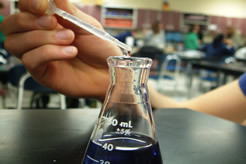
Although a number of U.S. organizations develop occupational exposure limits (OELs), much of the effort has focused on a relatively small subset of high volume chemicals, or those with particularly severe toxic end points. As a result, many workers are exposed to substances for which no guidance on acceptable exposure levels has been developed. The shortfall in protection of worker health due to the limited number of OELs suggests that active participation by TERA in this area is consistent with our mission to use the best available science for development of risk values to protect public health. TERA’s goal is to work cooperatively with other organizations’ efforts to see that more OELs are developed and take full advantage of advances in risk assessment methods.
Expanding the current coverage of OELs is valuable to companies and in the public interest because it:
![]() Enhances Product Stewardship efforts by providing more complete health and safety guidance to product users.
Enhances Product Stewardship efforts by providing more complete health and safety guidance to product users.
TERA works to support OEL development through two distinct programs: development of sound OELs by TERA staff, and organizing independent peer reviews of values developed by others.
Development of OELs and Documentation
We develop new OELs for chemicals of interest to you and your company or agency. To develop an OEL for you, we perform a comprehensive review and evaluation of the scientific literature and derive occupational values based on sound science and state-of-the-art risk assessment methods.
Independent Peer Review of OELs
An essential element in the acceptance of newly derived risk values is a scientific peer review. TERA’s Peer Review program provides a forum for independent scientific peer review of OELs developed by industry or government. TERA peer reviews bring together scientists from academic, government, and industry backgrounds providing a balanced review by experts in the fields of toxicology, occupational health, and risk assessment.

TERA has diverse corporate experience in supporting the occupational toxicology needs of our project sponsors. Below are descriptions of recent projects.
![]() Screening Level OELs. For a private sponsor evaluated available toxicology data and developed equipment cleaning validation limits and screening level OELs for pharmaceutical ingredients.
Screening Level OELs. For a private sponsor evaluated available toxicology data and developed equipment cleaning validation limits and screening level OELs for pharmaceutical ingredients.
![]() Bromopropane – an analysis of issues and considerations for developing an occupational exposure limit for 1-bromopropane was developed. The analysis relied on benchmark concentration modeling and consideration of neurological versus reproductive toxicity as alternative critical endpoints. Link to Document
Bromopropane – an analysis of issues and considerations for developing an occupational exposure limit for 1-bromopropane was developed. The analysis relied on benchmark concentration modeling and consideration of neurological versus reproductive toxicity as alternative critical endpoints. Link to Document
![]() IDLH – Immediately Dangerous to Life or Health (IDLH) values are 30-minute airborne concentrations developed to protect against severe irreversible effects or effects that might impair escape from exposure environments should respiratory protection or other control measures fail. IDLH methods research and documentation supporting new values are being developed.
IDLH – Immediately Dangerous to Life or Health (IDLH) values are 30-minute airborne concentrations developed to protect against severe irreversible effects or effects that might impair escape from exposure environments should respiratory protection or other control measures fail. IDLH methods research and documentation supporting new values are being developed.
![]() Scientific Criteria for Deriving Occupational Exposure Limits. In a project sponsored by the International Council on Mining and Metals, authored a manuscript providing a critical analysis of the scientific criteria for deriving occupational exposure levels.
Scientific Criteria for Deriving Occupational Exposure Limits. In a project sponsored by the International Council on Mining and Metals, authored a manuscript providing a critical analysis of the scientific criteria for deriving occupational exposure levels.
![]() Comparative Health Hazard Ranking. For a private sponsor, surveyed available health hazard ranking tools and methods, and provided a comparative analysis of selected systems for 12 substances for occupational and consumer exposure scenarios.
Comparative Health Hazard Ranking. For a private sponsor, surveyed available health hazard ranking tools and methods, and provided a comparative analysis of selected systems for 12 substances for occupational and consumer exposure scenarios.
![]() Risk Thresholds of Concern. For a private sponsor coauthored a report on the basis for setting risk assessment dose thresholds for occupational exposure to products for which full toxicity data are not available.
Risk Thresholds of Concern. For a private sponsor coauthored a report on the basis for setting risk assessment dose thresholds for occupational exposure to products for which full toxicity data are not available.
![]() Health and Safety Clearance of Chemicals. For a private sponsor developed a framework for conducting screening level risk assessments for chemicals newly introduced to facility operations. Won the “Best Risk Assessment Poster” at AIHC&E.
Health and Safety Clearance of Chemicals. For a private sponsor developed a framework for conducting screening level risk assessments for chemicals newly introduced to facility operations. Won the “Best Risk Assessment Poster” at AIHC&E.
![]() Job Safety Analysis. For the Cincinnati Parks Department, developed a health hazards summary and reviewed a job safety analysis for pruning of cacti that emit phorbol ester compounds. For a research university developed a database tool and protocol for evaluating laboratory safety procedures.
Job Safety Analysis. For the Cincinnati Parks Department, developed a health hazards summary and reviewed a job safety analysis for pruning of cacti that emit phorbol ester compounds. For a research university developed a database tool and protocol for evaluating laboratory safety procedures.
![]() Metal Refining Process Hazards. For a private sponsor, conducted a comprehensive toxicology and industrial hygiene review for a refining operation.
Metal Refining Process Hazards. For a private sponsor, conducted a comprehensive toxicology and industrial hygiene review for a refining operation.
![]() Dermal - a project is underway to apply the National Institute for Occupational Safety and Health’s weight of evidence procedures to assign notations that inform workers of potential systemic toxicity, direct skin effects, and sensitization potential from dermal exposures to chemicals. View Poster
Dermal - a project is underway to apply the National Institute for Occupational Safety and Health’s weight of evidence procedures to assign notations that inform workers of potential systemic toxicity, direct skin effects, and sensitization potential from dermal exposures to chemicals. View Poster
![]() Diacetyl - A toxicology review and issues analysis related to the availability of data to support OEL development for the butter-flavoring chemical, diacetyl, is under development. In particular, evaluation of issues related to interspecies extrapolation and effects of peak versus cumulative exposure are being considered. View Presentation
Diacetyl - A toxicology review and issues analysis related to the availability of data to support OEL development for the butter-flavoring chemical, diacetyl, is under development. In particular, evaluation of issues related to interspecies extrapolation and effects of peak versus cumulative exposure are being considered. View Presentation
![]() HPV, REACH, and screening Assessments - TERA provides support to a variety of sponsors in cataloging, critically evaluating, and developing robust data summaries, test plans, and risk assessment documents. We apply the latest guidance and novel systematic approaches to evaluate and present read-across strategies. View Brochure
HPV, REACH, and screening Assessments - TERA provides support to a variety of sponsors in cataloging, critically evaluating, and developing robust data summaries, test plans, and risk assessment documents. We apply the latest guidance and novel systematic approaches to evaluate and present read-across strategies. View Brochure
![]() Occupational Exposure Limits for Pharmaceuticals – published OELs are not available for most pharmaceuticals. To ensure that workers in the pharmaceutical industry are adequately protected we have develop systematic approaches for hazard banding as well as provisional and final OEL development for a variety of sponsors.
Occupational Exposure Limits for Pharmaceuticals – published OELs are not available for most pharmaceuticals. To ensure that workers in the pharmaceutical industry are adequately protected we have develop systematic approaches for hazard banding as well as provisional and final OEL development for a variety of sponsors.